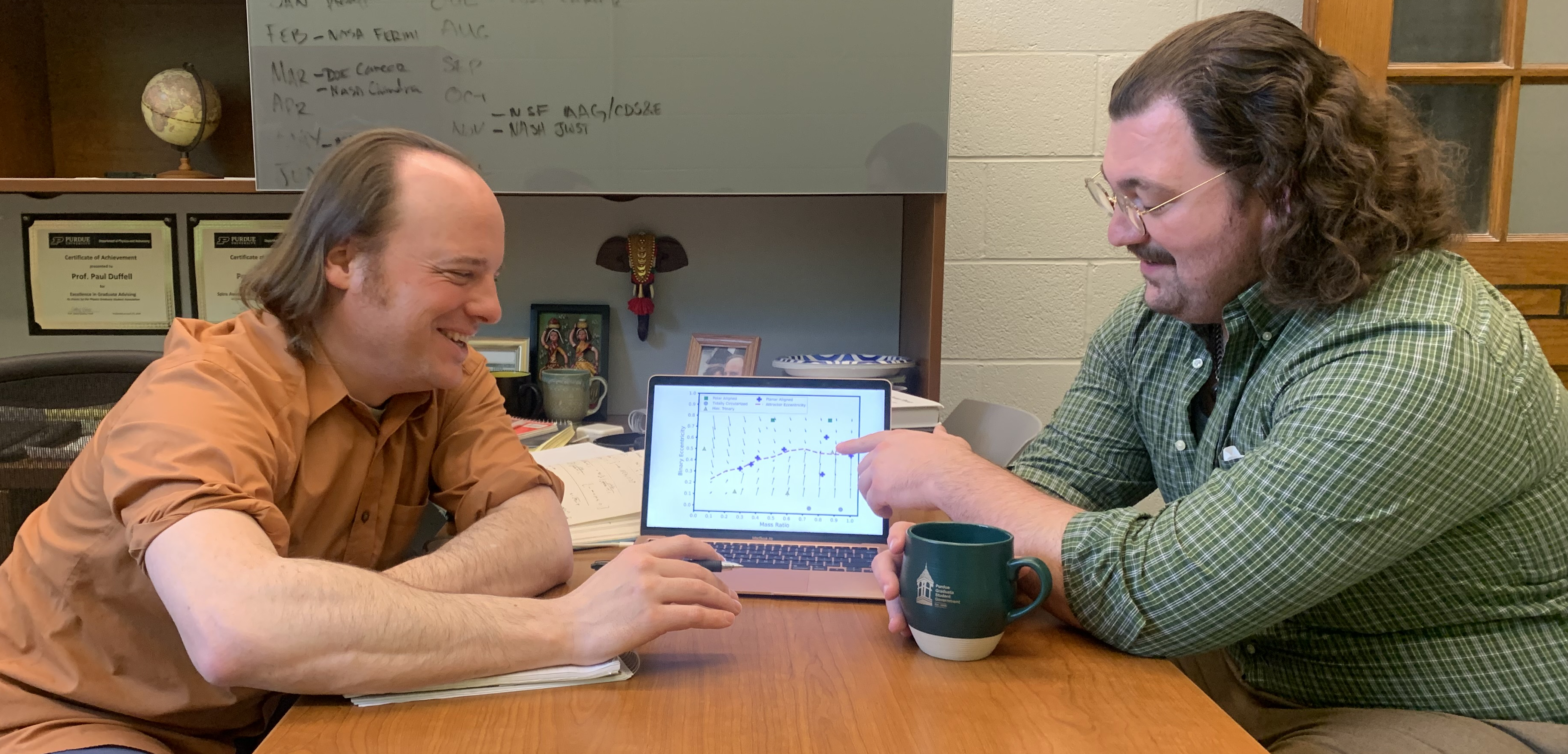Uncovering cosmic patterns: New discovery sheds light on binary star formation and evolution
2025-04-08

Paul Duffell and Allen Murray looked at the data on eccentric accreting binaries, showing that they obey the relationship predicted by theory. (Photo provided by Paul Duffell)
A discovery by Purdue researchers has provided a missing piece in our understanding of binary star systems, helping to resolve a difference between theoretical predictions and real-world astronomical observations. The findings, which focus on the orbital behavior of binary stars surrounded by circumbinary disks, offer new insight into the formation and evolution of these celestial systems.
Researchers Allen Murray, a graduate teaching assistant, and Assistant Professor Paul Duffell from the Physics and Astronomy Department at Purdue University have identified that disk alignment plays a big factor in this discovery. "Professor Paul Duffell assisted me in this discovery by pointing me in the right direction and providing ideas for different ways to look at the observational data," says Murray. “I was responsible for compiling, sorting, and displaying the observational data that was paramount to this discovery." By focusing the analysis on binary systems where the circumbinary disk aligns with the binary's orbit, the expected theoretical trend now appears in the observational data.
Murray’s research revolves around the orbital evolution of binary star systems with circumbinary disks. "I investigate the instabilities in the disk for a wide range of binary and disk parameters. This newly discovered pattern in accreting binary orbits matches with theoretical predictions for systems where the disk is aligned with the binary orbit," says Murray.
Binary star systems, which are pairs of stars orbiting a common center of mass, are a fundamental part of our galaxy's structure, making up a significant portion of all known stars. “Previous theoretical work showed that when binary stars are first formed, there is typically a disk of gas surrounding the binary, and interactions of that gas with the binary can drive the binary to an eccentric orbit,” says Duffell. “However, this theory predicts something very specific. It tells us that the binary should attract to a very specific eccentricity, which depends on the relative mass of the two stars in a very specific way. None of these detailed predictions had been seen in nature; standard catalogs of binary stars see eccentricities all over the place, with no discernable pattern.”
Allen and Duffell examined a subset of extremely young binary star systems that are just about a million years old, where the stars are still in the process of forming and remain surrounded by their original gas disks. By analyzing these actively accreting systems, the researchers found that the binary stars in disk-aligned systems do indeed exhibit the predicted eccentric orbits, with eccentricities matching the theoretical relationship to mass ratios.

Here is a simulation of a binary star system interacting with a disk, using a hydrodynamics code called DISCO developed by Duffell and used by Allen in the research group. (Photo provided by Paul Duffell)
“This suggests that the original theory is correct that disks can drive eccentricity in binary stars. But it looks like standard catalogs of older binary stars don't see this same pattern,” says Duffell. “We still need to understand what happens between the first million years and these few-billion-year-old systems that change the expected binary orbits. But an important piece of the puzzle is potentially solved here. During the early formation, the disk can drive the binary to an eccentric orbit exactly as the theory predicted.”
Understanding binary star systems is essential for many areas of astrophysics. These systems serve as laboratories for studying stellar evolution, gravitational interactions, and even the formation of planets. The discovery also highlights the importance of disk alignment, a factor that could influence future studies on how binary systems evolve over time. "Our discovery might be used to look for other trends in binary populations. These trends allow us to better understand the formation and dynamics of star systems," says Murray.
This discovery underscores the excellence of Purdue's astrophysics research community. The Duffell Research Group, led by Professor Duffell, played a crucial role in enabling this breakthrough, driven by a team of dedicated scientists. Murray emphasizes the impact of this collaborative effort, stating, "This type of research is happening at Purdue due to passionate faculty and driven graduate researchers such as myself."
The research was funded by the National Science Foundation under grant AAG-2206299. Moving forward, the team hopes to use their methodology to investigate other potential patterns in binary star systems and further refine our understanding of how these celestial structures evolve.
About the Department of Physics and Astronomy at Purdue University
Purdue’s Department of Physics and Astronomy has a rich and long history dating back to 1904. Our faculty and students are exploring nature at all length scales, from the subatomic to the macroscopic and everything in between. With an excellent and diverse community of faculty, postdocs and students who are pushing new scientific frontiers, we offer a dynamic learning environment, an inclusive research community and an engaging network of scholars.
Physics and Astronomy is one of the seven departments within the Purdue University College of Science. World-class research is performed in astrophysics, atomic and molecular optics, accelerator mass spectrometry, biophysics, condensed matter physics, quantum information science, and particle and nuclear physics. Our state-of-the-art facilities are in the Physics Building, but our researchers also engage in interdisciplinary work at Discovery Park District at Purdue, particularly the Birck Nanotechnology Center and the Bindley Bioscience Center. We also participate in global research including at the Large Hadron Collider at CERN, many national laboratories (such as Argonne National Laboratory, Brookhaven National Laboratory, Fermilab, Oak Ridge National Laboratory, the Stanford Linear Accelerator, etc.), the James Webb Space Telescope, and several observatories around the world.
Written by: David Siple, Communications Specialist, Purdue University Department of Physics and Astronomy
Contributions by: Allen Murray and Paul Duffell